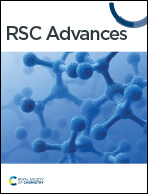Electrospun Cu–Co ferrite nanofibers: synthesis, structure, optical and magnetic properties, and anti-cancer activity†
Abstract
In this study, we investigated Cu–Co ferrite nanofibers (NFs) that were synthesized for the first time employing the electrospinning technique. The structure, phase purity and crystallite size of all the prepared NFs were revealed by powder X-ray diffraction (PXRD) analysis. The NFs crystallized in the Fd![[3 with combining macron]](https://www.rsc.org/images/entities/char_0033_0304.gif) m (no. 227) space group and the cation distribution arrangement over distinct sites in their structure was analyzed. Scanning electron microscopy (SEM) together with energy-dispersive X-ray (EDX) spectroscopy analysis showed the microstructure of the NFs and verified their expected chemical compositions. High-resolution transmission electron microscopy (TEM) images confirmed the fibrous nature and the construction of the NFs. The band gap energies derived from the UV-vis reflectance spectra showed a blue shift with an increase in the amount of Cu in the sample from 1.42 eV to 1.86 eV. Magnetization (M) as a function of magnetic field (H) measurements performed at ambient and low temperatures showed the ferrimagnetic behavior of all the NFs. The magnetic parameters including coercivity (Hc), saturation magnetization (Ms), remanent magnetization (Mr), and squareness ratio were determined from the recorded magnetization curves. At 300 K, Ms was reduced from 78.8 to 42.4 emu g−1, Mr reduced from 22.8 to 7.6 emu g−1 and the Bohr magneton reduced from 3.3 to 1.8μB with an increase in the content of Cu in the samples. The same trend was observed at 10 K, where Ms was reduced from 93.7 to 50.9 emu g−1, Mr reduced from 60.9 to 35.9 emu g−1 and the Bohr magneton reduced from 3.94 to 2.16μB. Alternatively, Hc has the highest values for x = 0 (850 Oe at 300 K and 5220 Oe at 10 K) and x = 0.6 (800 Oe at 300 K and 5400 Oe at 10 K). The anti-cancer activity of the NFs was evaluated using the MTT cell viability assay, showing a reduction in the viability of both HCT-116 and HeLa cancer cells compared to non-cancerous HEK-293 cells after treatment with the NFs. Apoptotic activity was examined by DAPI staining, where treatment with the NFs induced chromatin condensation and nuclear disintegration in HCT-116 cells.
m (no. 227) space group and the cation distribution arrangement over distinct sites in their structure was analyzed. Scanning electron microscopy (SEM) together with energy-dispersive X-ray (EDX) spectroscopy analysis showed the microstructure of the NFs and verified their expected chemical compositions. High-resolution transmission electron microscopy (TEM) images confirmed the fibrous nature and the construction of the NFs. The band gap energies derived from the UV-vis reflectance spectra showed a blue shift with an increase in the amount of Cu in the sample from 1.42 eV to 1.86 eV. Magnetization (M) as a function of magnetic field (H) measurements performed at ambient and low temperatures showed the ferrimagnetic behavior of all the NFs. The magnetic parameters including coercivity (Hc), saturation magnetization (Ms), remanent magnetization (Mr), and squareness ratio were determined from the recorded magnetization curves. At 300 K, Ms was reduced from 78.8 to 42.4 emu g−1, Mr reduced from 22.8 to 7.6 emu g−1 and the Bohr magneton reduced from 3.3 to 1.8μB with an increase in the content of Cu in the samples. The same trend was observed at 10 K, where Ms was reduced from 93.7 to 50.9 emu g−1, Mr reduced from 60.9 to 35.9 emu g−1 and the Bohr magneton reduced from 3.94 to 2.16μB. Alternatively, Hc has the highest values for x = 0 (850 Oe at 300 K and 5220 Oe at 10 K) and x = 0.6 (800 Oe at 300 K and 5400 Oe at 10 K). The anti-cancer activity of the NFs was evaluated using the MTT cell viability assay, showing a reduction in the viability of both HCT-116 and HeLa cancer cells compared to non-cancerous HEK-293 cells after treatment with the NFs. Apoptotic activity was examined by DAPI staining, where treatment with the NFs induced chromatin condensation and nuclear disintegration in HCT-116 cells.



 Please wait while we load your content...
Please wait while we load your content...